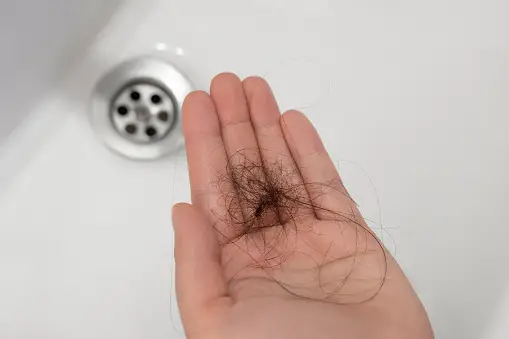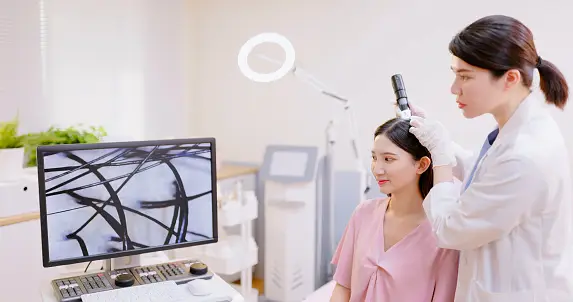You might not realize it, but your hair is constantly growing and falling out. The four primary phases of a typical hair growth cycle are the exogen (shedding phase), telogen (rest phase), catagen (regression phase), and anagen (growing phase). Ninety percent of your hair is growing right now, but as part of the typical shedding period, you may lose up to 100 hairs per day.
Numerous variables that impact the hair development cycle can cause hair loss, slower growth, or reduced fullness. These causes include hormone changes, autoimmune illnesses, sickness, aging naturally, numerous drugs, and even extreme stress. Changes in hair growth can be distressing and have a detrimental impact on your quality of life, even when they are not life-threatening.
Fortunately, there are a number of techniques you may try to encourage faster and thicker hair growth, such as altering your hair care regimen, applying topical treatments, and following a doctor’s recommendation.
Table of Contents
How Fast Does Hair Typically Grow?

The average person has between two and five million hair follicles on their body. Everywhere on the body, including the face, arms, legs, and armpits, hair grows. Yet, of the approximately 100,000 hair follicles on your head, the majority of hair grows there.
Your hair typically grows half an inch in a given month. The majority of hair grows for about six years before falling out and growing back in.
The four basic phases of a typical hair development cycle are the anogen, catagen, telogen, and exogen phases. Here are some details regarding each phases:
- Phase of anagen: active growth of hair. 90% of your hair is typically in this stage
- In the catagen phase, follicle-to-hair separation occurs and hair development slows down. This stage affects 10% or less of your hair.
- The telogen phase, during which hair is neither growing nor shedding, is the resting stage of hair growth. Five to ten percent of hair is in this stage.
- The exogen phase is the stage of hair loss. During this stage, it’s typical to lose up to 100 hairs per day
Factors Influencing Hair Growth

Numerous factors influence the thickness, texture, and development of hair. Numerous factors, including hormone fluctuations, aging naturally, and inherited factors, are beyond your control.
Various factors can influence the growth of your hair, such as:
Aging
As you age, it’s common for your hair to become thinner and less plentiful. Hormonal fluctuations regulate the age at which this occurs, as well as its rate of occurrence, to a great extent. Men are typically more affected by these changes than women are.
Male pattern baldness typically begins in middle life, however it can happen as early as the teen or twenties. Up to 80% of males will have male pattern baldness in one form or another by the time they turn 70.
Disease or Hormonal Shifts
The rate at which hair falls out might be affected by certain medical problems. For instance, hair loss may result after a high temperature. Postpartum hair loss is the term for the considerable hair loss that many parents experience after giving birth (despite having a thicker head of hair during pregnancy). Significant blood loss, infections, and other disorders can all result in hair loss.
Extreme Stress
When you go through your hair after periods of extreme stress or mental turmoil, you can discover that the majority of the hair gathers on your brush or between your fingers. This could happen following a traumatic event, a breakup or divorce, or the death of a loved one. Within nine months, the hair loss should stop and your hair should grow and fall at its typical rate once the stress has subsided.
Disorders of Hair Growth and Medical Concerns
A number of medical conditions might aggravate hair loss. Among them are:
- Alopecia areata, characterized by patches of baldness on the scalp and other areas
- Burns on the scalp
- Hair loss as a result of radiation or chemotherapy (cancer treatment)
- Anemia (low iron)
- Infections on the scalp caused by bacteria
- Hormone abnormalities
- Tinea capitis, or scalp ringworm
- Autoimmune disorders like lupus
- Thyroid disorders
Several Other Reasons
The following are some variables that could cause hair loss:
- Trichotillomania, or the disorder of pulling hair
- Hairstyles that tug on the follicles in your hair
- diets that drastically cut down on protein
- Side effects from birth control pills, retinoids, beta-blockers, NSAIDs, and certain antidepressants
How to Get Your Hair to Grow Faster

When the situation improves, your hair growth will naturally accelerate if you are experiencing greater hair loss due to conditions like severe stress, sickness, or postpartum changes.
There are times, though, when you might wish for fuller, thicker hair or to accelerate the growth of your hair. The American Academy of Dermatology Associations (AADA) states that there are a number of easy techniques you can try either alone or with medical assistance.
Alter Your Hair Routine
Tightly pulling your hair back into a ponytail, bun, or cornrow-style braids can cause damage to your hair and exacerbate hair loss. The same applies to sleeping with hair rollers on or spending a lot of time using hair extensions. If you would like to follow these tips and give your hair more time to be loose and relaxed, experts advise switching up your hairdo on a regular basis.
Modify Your Hair Care Routines
Among the hair care practices that lessen hair damage are:
- Reducing the frequency of using conditioner
- Allowing your hair to dry naturally as opposed to blow drying it
- Wear a swim cap to protect your hair when swimming in a pool, or give your hair a good wash afterward.
- Utilize fewer items that promise a “longer hold.”
- Limit the amount of hair coloring and perms you get, or wait longer between appointments.
Coily hair is very vulnerable to injury and may need extra attention. Some advice is to wash your hair no more than once a week, condition your hair generously, experiment with hot oil treatments, use heat-protective products, and straighten your hair with an iron or ceramic comb.
Think About Using Minoxidil
The over-the-counter (OTC) medication Rogaine (minoxidil) is an FDA-approved topical therapy for hair loss.
Applying minoxidil straight to the scalp once or twice a day promotes hair growth, halts further hair loss, and thickens the hair. The daily treatment is necessary for maximum effectiveness, and it may take six to twelve months to see effects.
Microneedling
Handheld equipment with several small needles are known as microneedling instruments. Studies have indicated that when paired with medications like corticosteroids or platelet-rich plasma, or with therapies like minoxidil, patients often experience increased hair growth, despite the paucity of evidence on their usage in hair growth.
Supplements
It could be beneficial to take some vitamin supplements to promote hair growth. The American Dental Association, however, suggests that consumers take these supplements only after a medical professional has found that they are lacking in certain nutrients. Supplements including iron, zinc, or biotin may aid in hair development.
Some seek for herbal therapies in an attempt to promote hair growth. These could include ginkgo biloba, grape seed, emu oil, primrose oil, nettles, sage, and rosemary oil. It is crucial to keep in mind that the FDA does not control the production of herbal supplements, and that these agents have not been the subject of extensive research.
Professional Hair Loss Treatments
Dermatologists and other medical specialists can provide medical therapies for hair loss after making a diagnosis. The exact course of treatment you take will depend on what is most effective for your unique diagnosis and any additional underlying medical issues you may have.
Among the medical procedures used to address hair loss are:
- Laser treatment
- Injections of corticosteroids
- Platelet-rich plasma PRP
- prescription drugs like Spironolactone (for female hair loss) or Finasteride (Propecia)
When to Consult a Medical Professional

A healthcare professional is the only one who can diagnose your hair loss situation. Hair loss can have many different reasons. You ought to think about consulting a medical professional if:
- You are experiencing noticeable hair loss and are in your teens or twenties.
- Your hair loss appears to be occurring in an unusual manner, like patches.
- You have hair loss in addition to discomfort, itching, or red, scaly skin.
- Despite being a woman, you have male pattern baldness-like hair loss.
- You have facial hair (for females only) or irregular menstrual periods in addition to your hair loss.
- Along with hair loss, you also experience physical symptoms including weakness, weariness, and a cold intolerance.
After consulting with a healthcare professional, you can find out what is causing your hair loss. During the consultation, your physician will assess your skin and hair, obtain a comprehensive medical history, and inquire about the nature and timing of your hair loss.
To determine what’s causing the hair loss, several tests might be carried out, including:
- Blood testing to check for illnesses, hormone problems, and vitamin deficiencies that could be the cause of the hair loss
- Scalp biopsies to identify bacterial, fungal, or other causes
An Overview
In and of itself, hair loss is harmless, but if it stresses you out, that’s natural. It seems sense that you would be seeking for methods to get more fullness and growth in your hair.
It’s crucial that you address any medical treatments or concerns with a healthcare provider, even while there are a number of potential at-home therapies and lifestyle/hair care adjustments you may do to boost hair growth.
In certain cases, getting medical attention or prescription medication may be required to speed up hair growth.
